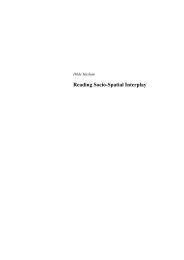CON ⢠TEXT - Arkitektur- og designhøgskolen i Oslo - AHO
CON ⢠TEXT - Arkitektur- og designhøgskolen i Oslo - AHO
CON ⢠TEXT - Arkitektur- og designhøgskolen i Oslo - AHO
- No tags were found...
Create successful ePaper yourself
Turn your PDF publications into a flip-book with our unique Google optimized e-Paper software.
R E S E A R C H I N G D K Stension filled. The pr<strong>og</strong>ram’s Achilles heel is the divided responsibility”(Borgen and Brandt 2006:9). 19 These two sectors represent different values,and collaboration will prompt the ‘school world’ and ‘art world’ to displaytheir values. As long as the explicitly stated mandate is to strengthen theeducation within the subject A&C, not to replace it or exist outside of it(KKD 2007; Skjelbred 2007), and the funding is located within the culturesector, while the practice is located within the school institution, it sometimesmakes for an uneasy alliance. This is where some of the challenges lie. Howdo the field of art, the educational aims that exist as a given on a general levelfor schools, and subject-matter specific for the school subject A&C manageto coexist within the practice of DKS?This dilemma exists at all levels of the collaboration, also with professionsoperating in the same space. The DKS project is a good case to explore theschool subject in terms of professional struggle pertaining to content, qualityand further development, and on the inclusion of art and design in a schoolthat is increasingly knowledge focused. It will also unveil opposing claims ofownership within the DKS pr<strong>og</strong>ram over said knowledge and contentchoices. These claims of ownership, made both publicly and at institutionallevel will influence the work practice, and be of importance in the discussionnot only of the execution of DKS, but of the rec<strong>og</strong>nition of the professionalteacher.An Insider and Outsider View of Educational PracticeAs the DKS pr<strong>og</strong>ram in Visual art brings t<strong>og</strong>ether professionals from twodifferent worlds - the ’school world’ and the ’art world’, they bring theirpreconceptions and professional views into the work setting, and rationalizetheir choices from these. As a double practitioner in this, I am both an A&Cteacher and an A&C education researcher. However, if I in my research amnot constantly aware of this, it can also be a bias that influences the results(Larsson 2005). This forces me to consider my own role and preconceptionscarefully before advancing any further with the study.In terms of Art and design didaktik research — I will return to the conceptdidaktik fully later — to step away from the practice, and the pedag<strong>og</strong>icaltheory to assume a wider framework to accommodate all these parts can bevaluable. It can be argued that it might not be entirely possible to free myselffrom the values and views gained from the professional field I was trained in,and placing myself within a qualitative research tradition focusing on‘matters of concern’ rather than ‘matters of fact’ (Latour 2004), the19 OQ: “Forholdet mellom skole- <strong>og</strong> kunst- <strong>og</strong> kultursektorene i Den kulturelle skolesekken viser seg å væremangfoldig men spenningsfylt. Ordningens akilleshæl er det delte ansvaret”.11
















